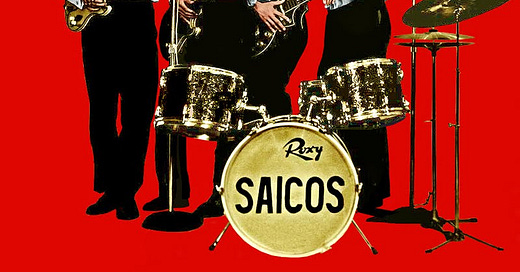Before punk had a name, before The Ramones or The Sex Pistols made safety pins and sneers fashionable, there was a group of unruly teenagers in mid-1960s Lima, Peru, who played faster, screamed louder, and thrashed harder than almost anyone else at the time. They called themselves Los Saicos—and their raw, explosive sound helped shape what we now recognize as punk rock.
The Birth of Chaos in Lima
Los Saicos formed in 1964 in the working-class district of Lince, Lima. The band—comprising Erwin Flores (vocals), Rolando Carpio (guitar), César “Papi” Castrillón (bass), and Pancho Guevara (drums)—emerged from a local scene that was more familiar with romantic ballads than rebellious rock.
But Los Saicos weren’t interested in soft melodies. Their music was an adrenaline shot of garage rock, surf, and something darker, louder, and more visceral. Their early singles, including “Demolición”, “Fugitivo de Alcatraz”, and “Salvaje”, were wild, unhinged, and entirely ahead of their time. Erwin Flores’s guttural screams and the band’s driving beats sounded more like Iggy Pop than The Beatles.
Originally, the band considered calling themselves Los Sádicos—“The Sadists”—a nod to their aggressive, antisocial energy. But concerned it might be too controversial for radio play, they opted for a clever workaround: Los Saicos, a play on both sádicos and the English word “psycho.” Some say the name was inspired by the film Psycho and that they spelled it phonetically in Spanish as “Saicos.” It kept the menace but was ambiguous enough to slip past censors—and iconic enough to stick.
At a time when rock was still seen as relatively clean-cut, Los Saicos were making music that was noisy, rebellious, and full of destruction. Their 1965 hit “Demolición” literally calls for blowing up a train station—and it became a massive local success. Without knowing it, they had crafted a sound that prefigured punk by nearly a decade.
Call it garage rock, proto-punk, or just unfiltered chaos—Los Saicos defied categorization. They weren’t copying what was happening in London or New York; they were creating something uniquely Peruvian and incredibly radical for the time.
Despite their local success (and a brief run as television personalities in Peru), Los Saicos were short-lived. By 1966, they had disbanded—without ever releasing a full album. Members moved on to other careers and lives, and the band was largely forgotten outside Peru.
But their music never disappeared completely. In the early 2000s, garage rock aficionados and punk historians began unearthing the band’s legacy. Bootleg compilations made their way into collectors’ hands, and soon the legend of Los Saicos began to grow.
In 2006, the unthinkable happened: Los Saicos reunited. With Erwin Flores at the front once more, they performed to enthusiastic crowds both in Peru and abroad, finally receiving the recognition they had been denied for decades. The band continued performing intermittently throughout the 2010s, welcomed as proto-punk forefathers in an era that had finally caught up with their vision.
A Legacy Etched in Punk History
Los Saicos may not have known they were inventing a genre, but that’s precisely what makes their influence so potent. Unlike later punk bands who played into a defined aesthetic, Los Saicos were raw and instinctive. They were punk before punk, screaming about destruction and fugitives in a time and place where no one else dared.
Their impact is now widely acknowledged among punk historians and musicians alike. They’re proof that revolutionary music can come from anywhere—and that sometimes, the future starts in the past.
Reference:
McDonnell, Evelyn. "The Peruvian Punk Before Punk: Los Saicos and the Screams That Shook Lima." Rolling Stone, 2011.



Always a delight to see that you’ve posted music and thoughts! Your mastery of music is appreciated.
Please tell me …how I can become a paying subscriber?
This application is not easy to navigate for the payments. Probably user error … but I’ve done this before and it has worked.
Is there a link that might be fool proof, because Substack directions are not helping.
Thank you in advance, and thank you for your awesome Substack!